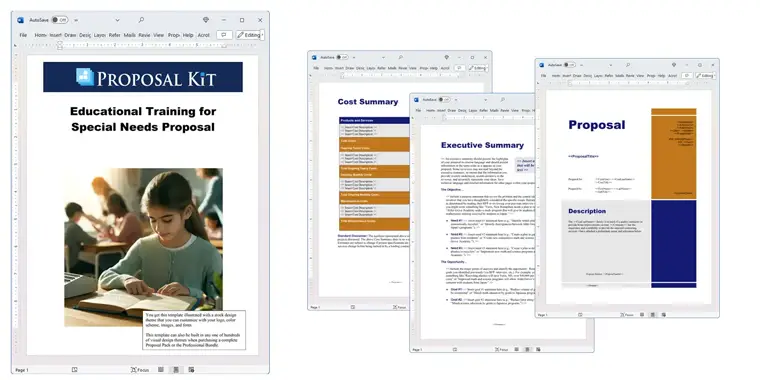How to write your Educational Training for Special Needs Proposal
We include this 22 page layout with every Proposal Pack. If you want this template to have a different visual design theme than the one illustrated here, purchase any Proposal Pack design and create this template using the purchased design theme. This template is included in every Proposal Pack. If you get a Proposal Pack or the Professional Bundle, you can also make any variation of this template with different chapters to suit your needs.
We typically include more chapters in the templates than most people will need to give everyone more variety in the chapters they may need. You can trim down a long template by removing pages you do not need or combining multiple chapter topics into one page.
 DOWNLOADABLE, ONE-TIME COST, NO SUBSCRIPTION FEES
DOWNLOADABLE, ONE-TIME COST, NO SUBSCRIPTION FEES If you need this template on DVD media order from our Amazon shop.
If you need this template on DVD media order from our Amazon shop.
You can also create countless variations of this document to suit your needs using the included library of 2200+ chapters if ordering a Proposal Pack or Pro Bundle.
 What Our Clients Say
What Our Clients SayThanks a lot for the information. I bought the "Proposal Pack" yesterday, and I am very pleased with what I have seen so far.…I am an engineering college professor, and I am using this (and other products) to show how projects should be structured."
Related Article
Related Video
Related Templates
- Grant Proposal for Special Needs Support
- Educational Grant Proposal
- Educational Grant Proposal #2
- Daycare Preschool Grant Funding Proposal
- DOE Federal Government Grant Proposal
- DOE Federal Government Grant Proposal #2
- STEM Educational Program Proposal
- Non-Profit Parenting Distance Learning and Workshop Proposal
- Distance Learning Education Proposal
- Mobile Literacy Program Funding Proposal
- Life Skills Tutoring Services Proposal
- Mobile Classroom Sales and Rental Proposal
- Training Plan
- Training Program Curriculum Innovation Proposal
- Educational Grant Proposal 2
- Medical Staffing Services Proposal Template
- Online School and Media Outlet Funding Proposal
- Vocational Education Proposal
- Specialized Training Educational Proposal
- Healthcare Staffing Proposal
- Training for Skills Development Proposal
- Healthcare Staffing Agency Proposal Template
- Vocational Job Training for Youth Proposal
- Training Services Proposal
- Moving Training Services Online Proposal
- Corporate Training Services Proposal Template
- Tutoring Educational Services Proposal
- School Funding Request Proposal
- School Improvement Project Proposal
- Sales Training Proposal Template
What's a proven way to write a proposal for your educational training for special needs?
The Proposal Kit software and template library are the most effective solutions for anyone creating an educational training proposal for special needs. With its comprehensive tools and templates, the Proposal Kit simplifies the proposal writing process, particularly for those new to the task. The integrated line item quoting database system facilitates the creation of detailed financial documents like cost summaries, quotes, estimates, and budgets, ensuring your proposal's financial aspects are thoroughly presented.
Are you planning to write a proposal to secure funding for an educational training project for special needs?
What Types of Projects Are Educational Training for Special Needs Proposals Written For?
Educational training programs for special needs are diverse and tailored to various learning requirements. Here are examples of ten types of projects:
- Inclusive Classroom Resources: Development and provision of adaptive learning materials.
- Specialized Technology Tools: Software and hardware that assist learning for students with disabilities.
- Therapeutic Programs: Activities to improve physical, mental, and emotional well-being.
- Professional Development for Educators: Training programs on special education techniques and compliance.
- Accessibility Improvements: Modifications to make educational facilities more accessible.
- Speech and Language Therapy: Programs to assist students with speech-related challenges.
- Behavioral Intervention Services: Support for students with behavioral needs.
- Occupational Therapy: Activities aimed at developing daily living skills.
- Autism Support Programs: Tailored educational strategies and tools for students on the autism spectrum.
- Assistive Learning Devices: Tools that help overcome learning barriers.
Chapters this template is built with
Using Proposal Kit's templates, these topics will help create a comprehensive, clear, and winning educational training proposal for special needs, maximizing your project's chances of securing the necessary funding.
These templates are just a few examples from the extensive Proposal Kit library. Customize your proposal to include all necessary topics, making it a comprehensive document addressing every project aspect.
Cover Letter
Begin your proposal with a cover letter introducing your organization and personalizing your commitment to special education. This letter should reflect your team's passion and dedication to this project, briefly stating the goals and the impact you aim to achieve. It sets the tone for the proposal, establishing a connection with the recipient and highlighting your organization's qualifications in a compelling, personable manner.
Executive Summary
The Executive Summary is crucial as it condenses your project into a straightforward, impactful narrative. Here, you must briefly explain the necessity for specialized training and outline the anticipated positive outcomes for participants. This summary should capture the essence of your proposal, emphasizing how your project will meet specific needs within the special education community and the long-term benefits it seeks to achieve.
Cost Summary
Use the Cost Summary template to provide a transparent and detailed breakdown of all expected costs associated with your project. This section should cover everything from staffing and materials to administrative expenses and any indirect costs. Clarity and accuracy in this part reassure funders that their investment is calculated and will be used judiciously.
Getting Started
Outline the preliminary steps of your project, from initial assessments and staff training to the program's launch. This section should serve as a roadmap that details the early phases of your project, showing a clear path from conception to actual execution, which helps establish trust in your project's feasibility.
Training Plan
Describe your approach to training within the proposal. Highlight how your training methods are specifically adapted to meet the needs of special education students, including any innovative techniques or technologies you plan to use. This plan should cover the training's scope, objectives, and methodology, emphasizing its tailored nature.
Lesson Plan
Detail the structure of individual lessons or sessions within your educational program. This template should highlight the educational content, teaching methods, and how these are adapted to cater to various special needs. Include how these plans engage students and facilitate measurable learning outcomes.
Assistance
Explain the range of support services that will be available to aid students throughout their educational journey. This might include tutoring, mentorship, and personalized assistance to help students overcome specific challenges. Highlighting this support underscores your commitment to comprehensive student care.
Tutoring
Explain the specifics of the tutoring services your program will offer. This section should emphasize how tutoring is customized to meet individual student needs, possibly incorporating examples of adaptive strategies for different learning disabilities.
Dates and Times
Clarify the program's scheduling, detailing the start and end dates, the frequency of sessions, and any important milestones. A clear timeline ensures that all stakeholders understand the program's duration and key dates, which aids in planning and logistics.
Access
Discuss your strategies for ensuring that all aspects of your program are accessible to every student. This includes physical access to facilities and digital access to resources, ensuring compliance with ADA standards, and reflecting a commitment to inclusivity.
Enrollment
Outline a straightforward, inclusive enrollment process that allows easy access for all interested parties. This section should address any potential barriers to entry and describe how these will be mitigated to ensure that no eligible student is excluded.
Courses
Provide details on the courses offered within the program, emphasizing their design and relevance to special needs education. Explain how these courses address specific educational goals and how they are adapted to cater to the varied needs of the students.
Materials
List all educational materials you will use, noting features that enhance accessibility and learning. This might include braille books, audio recordings, or software specifically designed for special education needs.
Special Needs
Specifically, address how your program is designed to meet diverse special needs. Detail the accommodations and modifications to ensure each student receives the support necessary to succeed.
Evaluation
Explain the evaluation methods used to measure the program's effectiveness. This should include qualitative and quantitative metrics and demonstrate how these methods will assess student learning and satisfaction improvements.
Company History
Share a brief history of your organization, emphasizing its mission and achievements within special education. Highlight past successful projects to establish a track record of reliability and commitment.
Certifications
List any relevant certifications that enhance your organization's credibility in delivering special needs education. These certifications demonstrate compliance with industry standards and a professional commitment to quality.
Endorsements
Include endorsements from reputable educational bodies, experts in special education, or community leaders. Such endorsements can significantly enhance the credibility of your proposal, lending it additional weight and authority.
Personnel
Detail the qualifications and roles of key staff members involved in the project. Emphasize their special education expertise, experience with similar projects, and ability to connect with and teach students effectively.
Use cases for this template
Story of Emily and Bright Futures Academy
Emily, the founder of Bright Futures Academy, faced the challenge of securing funding to launch a program tailored for students with learning disabilities. Recognizing the importance of a well-written proposal, Emily turned to Proposal Kit, which provided her with the necessary tools to detail the innovative aspects of her program.
Her proposal described how integrating advanced technology and personalized learning plans would be game-changers in special education. These plans included adaptive software that adjusts to each student's learning pace and style, enhancing the educational experience and fostering better academic outcomes. The structured templates from the Proposal Kit allowed her to logically organize her thoughts and present her ideas clearly and professionally.
This streamlined the proposal writing process and significantly boosted the proposal's persuasiveness, ultimately helping her secure the funding needed to make her vision a reality. The successful funding marked a significant milestone for Bright Futures Academy, enabling it to implement a program that truly makes a difference in the lives of its students.
Lucas and Inclusive Learning Consultants
Lucas, a project manager at Inclusive Learning Consultants, was racing to draft a proposal for a new therapeutic program for children with special needs. With the deadline approaching, Lucas used Proposal Kit's comprehensive structure to organize and expedite his writing process.
To further enhance the proposal, he integrated AI technology to assist in drafting content that detailed the program's therapeutic benefits and logistical elements. The AI tool enabled him to quickly generate tailored content that aligned with the program's specific needs and goals, such as therapy schedules, equipment needs, and staff training. The combination of Proposal Kit's templates and AI-generated text created a winning, well-constructed proposal that conveyed the need and potential impact of the therapeutic program.
Lucas's use of these tools allowed him to submit the proposal on time, impress his superiors, and secure the necessary funding, demonstrating the power of blending traditional and modern approaches in proposal writing.
Ava and Global Education Initiative
Ava, the director of Global Education Initiative, was tasked with drafting an RFP for expanding autism support services. Ava chose the Proposal Kit for its proven effectiveness in creating detailed, clear documents. She used the templates to outline every aspect of the project, from the scope and objectives to the specific services needed, such as behavioral therapy, sensory-friendly learning environments, and parent education.
This comprehensive detailing ensured that the RFP was complete and transparent, facilitating a better understanding among potential providers about the project's requirements. The precision and clarity of the RFP created with the Proposal Kit helped attract a wide array of qualified providers, enabling a competitive and effective selection process.
This led to the program's successful expansion, significantly enhancing the support services available for students with autism and reinforcing the Global Education Initiative's commitment to providing specialized and impactful educational support.
Conclusions and Recommendations
From drafting detailed financial documents to structuring comprehensive educational programs for special needs, the Proposal Kit is invaluable for anyone looking to create educational training for special needs proposals. Through its user-friendly templates and extensive resources, Proposal Kit enables users to communicate their projects' value and secure the necessary funding.
Also Known As
This template may also be referred to in different ways or be used in more specialized situations, such as:
- Special Needs Education Initiative Proposal
- Inclusive Education Program Plan
- Proposal for Training in Special Education
- Special Education Development Proposal
- Adaptive Education Training Scheme
- Proposal for Enhanced Learning for Special Needs
- Specialized Instruction Training Proposal
- Comprehensive Education Plan for Special Needs
- Differentiated Education Training Proposal
- Proposal for Special Needs Educational Enhancement
Abstract
 Educational training proposals for special needs play an important role in ensuring that children with disabilities receive a quality education alongside their peers in the least restrictive environment. These proposals, such as those facilitated by the Proposal Kit software, offer a vital bridge between special education programs and the funding needed to implement them. Special education teachers and administrators are responsible for creating engaging and inclusive curriculums that accommodate students' unique needs while also adhering to legal requirements, such as the Disabilities Education Act. Through individualized education programs (IEPs), special educators provide students with specially designed instruction tailored to their learning styles, fostering lifelong learning and success in both special education settings and general education classrooms.
Educational training proposals for special needs play an important role in ensuring that children with disabilities receive a quality education alongside their peers in the least restrictive environment. These proposals, such as those facilitated by the Proposal Kit software, offer a vital bridge between special education programs and the funding needed to implement them. Special education teachers and administrators are responsible for creating engaging and inclusive curriculums that accommodate students' unique needs while also adhering to legal requirements, such as the Disabilities Education Act. Through individualized education programs (IEPs), special educators provide students with specially designed instruction tailored to their learning styles, fostering lifelong learning and success in both special education settings and general education classrooms.
The demand for inclusive education has grown, prompting school districts and policymakers to advocate for better integration of special education services within the general curriculum. The success of such initiatives often relies on collaboration between special education teachers, general education teachers, and family members, who work together to identify and implement effective high-leverage practices. Evidence-based resources and assistive technologies are employed to help struggling students meet grade-level standards in subjects like math and reading, while specialized support services, such as speech therapy and occupational therapy, address additional needs.
To accommodate the diverse needs of children with disabilities, local schools are encouraged to provide students with access to adapted curriculums, technical assistance, and universal design principles. These efforts ensure that students with disabilities can participate in mainstream classrooms, gaining the same educational rights and opportunities as other students. As schools across the country and in other countries explore innovative approaches to special education, the importance of accountability and data collection remains paramount. By monitoring progress and adapting methods, educators can ensure that every student deserves the chance to thrive and reach their full potential in an inclusive setting, ultimately contributing to a more equitable educational system.
 Special education teachers and administrators face the ongoing challenge of balancing the unique needs of children with disabilities within the general education system. The individualized education program (IEP) serves as a cornerstone for ensuring that each child's disability is addressed through tailored instructional strategies and necessary accommodations. This collaborative process involves teachers trained in special education, counselors, and family members working together to develop comprehensive plans that integrate students into the same classrooms as their general education peers, providing them with a supportive and inclusive setting.
Special education teachers and administrators face the ongoing challenge of balancing the unique needs of children with disabilities within the general education system. The individualized education program (IEP) serves as a cornerstone for ensuring that each child's disability is addressed through tailored instructional strategies and necessary accommodations. This collaborative process involves teachers trained in special education, counselors, and family members working together to develop comprehensive plans that integrate students into the same classrooms as their general education peers, providing them with a supportive and inclusive setting.
Implementing these special education programs requires a multifaceted approach, encompassing curriculum adaptation and the use of assistive technologies to empower exceptional children. Schools must ensure that their infrastructure, including school buildings and transportation, meets the accessibility standards outlined by law, allowing students full participation in all educational activities. The integration of these topics facilitates a less restrictive environment, promoting equality and acceptance within the school culture.
In rural areas, where resources are limited, school districts must innovate to deliver quality education and needed services to children with disabilities. This might involve remote learning options or partnerships with other schools to share resources and expertise. At the state level, departments of education provide guidance and technical assistance, helping local schools navigate current practices and legal requirements to remain compliant while offering exceptional support to students.
 Regular communication between principals, administrators, and educators is important in monitoring progress and ensuring that every struggling student receives the support they need. By adopting high-leverage practices and using evidence-based resources, schools can address the intellectual and social needs of students with disabilities, encouraging them to engage with the general curriculum and develop critical skills in areas like math and social studies.
Regular communication between principals, administrators, and educators is important in monitoring progress and ensuring that every struggling student receives the support they need. By adopting high-leverage practices and using evidence-based resources, schools can address the intellectual and social needs of students with disabilities, encouraging them to engage with the general curriculum and develop critical skills in areas like math and social studies.
The push for inclusion has prompted districts and policymakers to advocate for more robust special education services, recognizing the importance of providing students with a diverse range of learning opportunities. This includes access to extracurricular activities and the arts, fostering a well-rounded educational experience. As society continues to evolve, the commitment to accommodating students with unique needs becomes increasingly vital, ensuring that every child can achieve success and contribute meaningfully to the world.
Frequently Asked Questions
What should a special needs education training proposal include?
When writing a special needs education training proposal, it's important to include a clear and concise introduction outlining the purpose and necessity of the program. Describe the target audience and their specific needs. Include detailed objectives and goals, a comprehensive methodology outlining the training strategies, and the curriculum to be used. Budget considerations, timelines, and evaluation methods to assess the program's effectiveness should also be included. Don't forget to highlight the qualifications and expertise of the team involved in delivering the training.
How do I identify the needs of the target audience?
Conducting a thorough needs assessment is crucial. This can be achieved through surveys, interviews, and focus groups with educators, parents, and specialists who work with special needs individuals. Review existing research and data on the specific disabilities or learning challenges the target audience faces. Understanding their unique requirements will help tailor the training program to address specific gaps in current educational practices and provide more meaningful support.
What should be the focus of the training objectives and goals?
The training objectives and goals should be SMART: Specific, Measurable, Achievable, Relevant, and Time-bound. They should focus on enhancing the skills and knowledge of educators in special needs education, improving student outcomes, and fostering an inclusive learning environment. Objectives might include improving teaching strategies, increasing awareness and understanding of various disabilities, and implementing adequate classroom accommodations and modifications.
How can I ensure my proposal is compelling and persuasive to stakeholders?
To make your proposal compelling, start with a strong executive summary that captures the essence of the proposal and its importance. Use data and evidence to support the need for the training program and include testimonials or case studies if available. Clearly articulate the benefits and potential impact of the program on both educators and students. Ensure the proposal is well-organized, professionally presented, and free from jargon. Highlight the credibility and experience of the team delivering the training.
What are the proposal's best budgeting and funding practices?
Provide a detailed and transparent budget that includes all potential costs, such as materials, trainer fees, venue costs, and any technology requirements. Break down the budget into clear categories and justify each expense with a rationale. Consider including a contingency plan for unexpected costs. Explore potential funding sources, such as grants, sponsorships, or partnerships with educational institutions and organizations. Demonstrate cost-effectiveness and potential returns on investment to appeal to funders.
15% Off Discount
![]() Add To Cart This Word Template Only
Add To Cart This Word Template Only
 Add To Cart Proposal Pack for Any Business
Add To Cart Proposal Pack for Any Business
 Add To Cart Proposal Kit Professional Bundle
Add To Cart Proposal Kit Professional Bundle
 4.7 stars, based on 846 reviews
4.7 stars, based on 846 reviewsProposal Kit chapters used in this template
Cover Letter, Title Page, Table of Contents, Executive Summary, Special Needs, Assistance, Access, Training Plan, Lesson Plan, Tutoring, Courses, Dates and Times, Materials, Personnel, Certifications, Enrollment, Cost Summary, Evaluation, Getting Started, Company History, Endorsements, Back Page
Included Calculator Spreadheets
These Excel calculator spreadsheets are included with this template. If you purchase a Proposal Pack or the Professional Bundle, these proposal pages are generated using an automated line-item database in the included Wizard software. The calculator spreadsheets are intended for use when purchasing only the static Word template.
You use this proposal for
- General business proposal
- Education, training proposal
- Non-technical proposal
- Project pitch proposal
How to create this template with Proposal Pack Wizard
You can create this document using any of the logo-designed Proposal Packs. Pick any Proposal Pack with a logo design theme you like best; they will all work equally well. The Proposal Pack for Any Business is the pack with no extra added logos or colors - designed to be used plain or for you to customize with your logos and graphics.
The Proposal Pack design theme you purchase will determine the visual look of this template. The screenshot above only shows the plain generic design theme. Names and stories in examples are fictional; however, the templates are from real client use cases.
We include a library of chapters to be assembled based on your needs. All proposals are different and have different needs and goals. We designed Proposal Pack so you can customize the documents to suit your needs.
You will best create this document using the Proposal Pack Wizard - Expert Edition software to select this template and build it in the Proposal Pack logo design theme of your choice along with any desired customizations (such as adding additional chapters, removing unneeded chapters, changing the order of chapters, and importing your company logo). This template outlines a proposal for the described situation. Each user is responsible for typing in the actual content of the provided pages with their information to complete the proposal. Suggestions in the abstract may include features in higher-end packages and are facilitated by the selection of chapter templates to support the narrative of each proposal, which help guide the user in filling in the details.
You create this template using the Wizard software with an entire Proposal Pack library and software. We include the Expert Edition of the software in the Proposal Kit Professional bundle. Microsoft Word for Windows is required to use the customizing software. You can also edit Word document templates in other office software such as Word for Mac. We will assist Mac users in assembling complex templates for their first project if they do not have the required platform to run the Wizard software.
You only get the single assembled Word document if purchased as a stand-alone template. The individual template products include no other templates, samples, or software.
How to Build Templates Featured on Proposal Kit Website
Many people find the Proposal Kit website after searching for a specific proposal. Once you've purchased and installed the software, how do you build that template you found in the first place? This video shows you how to build any proposal you see on the Proposal Kit website.
Key Takeaways
- The Educational Training for Special Needs Proposal is available as a ready-to-edit template.
- You can create unlimited custom variations of this template using a Proposal Pack or the Professional Bundle.
- Using a Proposal Pack or Professional Bundle, you can automate quotes and other financial pages with a line-item database.
- There are no ongoing subscription fees. You get lifetime unlimited use.
- We made Proposal Kit for freelancers, small businesses, and non-profits.
- Proposal Kit product content (templates, samples, software) is 100% written by humans.
 Ian Lauder has been helping businesses write their proposals and contracts for two decades. Ian is the owner and founder of Proposal Kit, one of the original sources of business proposal and contract software products started in 1997.
Ian Lauder has been helping businesses write their proposals and contracts for two decades. Ian is the owner and founder of Proposal Kit, one of the original sources of business proposal and contract software products started in 1997.By Ian Lauder
 Published by Proposal Kit, Inc.
Published by Proposal Kit, Inc.


 Cart
Cart


 Get 15% off ordering today:
Get 15% off ordering today: 

 Facebook
Facebook YouTube
YouTube X
X Search Site
Search Site